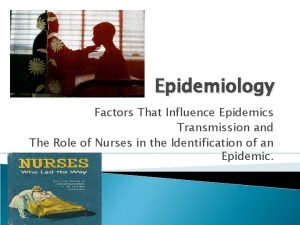Epidemiology and Epidemics What is epidemiology study of







- Slides: 7

Epidemiology and Epidemics

What is epidemiology? • study of the distribution and determinants of health problems populations – applying that information to control health problems – who diseases affect, what factors are involved, and how can it be contained

Epidemiologic Triangle • Agent (What) – microbe that causes the disease • Host (Who) – organism harboring the disease • Environment (Where) – external factors which allow or cause disease transmission

Epidemics and Pandemics • epidemic – more cases of a particular disease than expected in a given area/population – example: • Polio 1950 s – 58, 000+ cases and 3, 145 deaths • pandemic – a widespread epidemic across a large region – examples: • Influenza 1918 – infected about 1/3 of the world population, about 100 million deaths worldwide • HIV/AIDS • Black Death 1347 – killed about 1/3 of European population

Ebola • hemorrhagic fever • symptoms include: fever severe headache muscle pain/weakness fatigue vomiting and stomach pain – unexplained hemorrhage – – – • incubation period is between 2 -21 days (avg. 8 -10) • recovery depends on care • people who recover develop antibodies that can last for 10 years

Zika • Spreads mostly through mosquitos • Symptoms include: – – – Fever Rash Joint pain Red eyes Headache Muscle pain • Many people don’t get sick enough to go to the doctor…some are asymptomatic • Dangerous if infected during pregnancy – Linked to microcephaly and other severe brain defects in infants

Nipah • Transmitted through direct contact with pigs, bats, or infected people • Symptoms include: – – Fever Headache Drowsiness Disorientation and confusion • Can progress to a coma within 24 -48 hours • Long term effects include persistent convulsions and personality changes • 1999 outbreak nearly 300 infected with over 100 deaths • Annual outbreaks in Bangladesh are common













